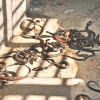The state of on-campus journalism

In 2022, Theo Baker, a freshman at Stanford University, decided to write an investigative story
about the University President, Marc Tessier-Levigne's research misconduct for the campus paper. His story caused a massive frenzy, even leading to legal threats to stop the publication of the articles.
But things changed after more reports delved into the details, and the university decided to launch an independent investigation. This investigation found the President guilty of some of the accusations, and it eventually led to his resignation.
Theo Baker's story highlights the pivotal role that campus newspapers and student journalists play in educational institutions and beyond. Student run newspapers are not just outlets for campus news; they serve as watchdogs, ensuring transparency, accountability, and ethical conduct within the university community.
In Bangladesh's higher education space, student-run campus newspapers are hardly active. In schools and colleges, they are almost non-existent. The space for students to acquire those journalistic skills is absent.
Regarding the importance of campus newspapers, Saquib Bin Raschid, a student at University of Liberal Arts Bangladesh (ULAB), says, "I think promoting student newspapers is necessary for every university, not just in universities that offer journalism as a major."
Saquib, who is a sub-editor for ULAB's student-run newspaper, The ULABian, thinks that student newspapers should be supported more, even if they're not seen as a typical extracurricular activity.
Talking about how working for The ULABian helped him, Saquib shares, "In my experience, my passion for writing led me to join the campus newspaper. When my piece was published last semester, the thrill of knowing faculty members would read it was amazing. I have also seen students enjoy a sense of confidence who have their work published."
Participating in a student publication equips individuals with a versatile skill set that goes beyond academics, preparing them for success in their future careers by enhancing their communication, editorial, critical thinking, leadership, and time management skills. Muskan Mortuza Mustarin, a student at Independent University, Bangladesh (IUB) and the director of content at IUB Journalism Club, shares, "Student newspapers are especially a great opportunity for aspiring journalists, offering practical experience and contributing to the overall educational environment of the university."
With lack of funding for print publication, student newspapers are evolving and adapting to the digital era by prioritising online content distribution over traditional print editions.
Rakin Ahmed*, a student at ULAB who previously served as the campus newspaper's editor, says, "At ULAB, the university allocates a budget for the paper each semester, printing typically fifty copies. Students handle the design and content. Due to limited copies and a larger student population, obtaining a physical copy can be challenging. Some copies go to the administration's office for distribution to high-profile individuals, meant to showcase ULAB's vibrant life. However, this limits access for the average ULAB student. To address this, we have been discussing a shift to digital distribution."
When asked what we can learn from the editorial practices of publications like The Stanford Daily and Harvard Crimson, Professor Sudeep Chakravarti, a South Asian writer of both narrative nonfiction and fiction, a media specialist, and Director of the Center for South Asian Studies (C-SAS) at ULAB, shares, "Universities need to learn to distinguish between a university brochure and a campus newspaper. Universities need to learn to be less insecure and trust the judgement of the student editorial team – after all, this is also a learning process that shapes future journalists and media leaders."
"Faculty teams need to be mentors instead of gatekeepers. And such student-led publications need to be inclusive, to include in recruiting, participation, and representation folks from across departments, and move beyond silos. Only then can you have a truly exemplary student-led publication from the POV of students, not the POV of a university's media department or the administration," adds Professor Chakravarti.
Limited editorial freedom also hinders students involved in the campus newspaper from participating in critical investigative reporting. While discussing the Stanford case, Rakin shares, "There's a lot of intervention by admin or faculty in Bangladesh. So, universities won't allow students to reveal such corruption because they want to save face and protect their own interests, as many appointments are political."
Rakin also highlights the trend of campus paper coverage that needs to change. "Often, many stories about students remain untold. For instance, if there's a brilliant entrepreneur on campus, student newspapers tend to prioritise faculty, administration, and event stories rather than showcasing that student's achievements. This trend needs to change. I believe it's crucial for someone to pick up a student newspaper, see themselves in it, and feel proud and connected to the university."
On the other hand, Kohinoor Sultana Elora, a journalist at BRAC University's student paper, BRACU Express, feels the newspaper could improve with increased funding. According to her, additional funding would facilitate more events and promotions, ultimately boosting interest in BRACU Express.
In response to the question of what challenges campus newspapers in Bangladesh face in maintaining high editorial standards, Professor Chakravarti shares, "I believe several campus newspapers are discouraged from holding high editorial standards, simply because so many are treated as brochures or are controlled by over-reaching faculty or a nervous administration. Universities might also be reluctant to fund such publications."
Many student journalists in Bangladesh are haunted by the spectre of censorship, and they have to walk a tightrope when it comes to critical reporting. "Whenever we are considering crafting or covering a story, we have to take three aspects into consideration," explains Rakin. "Anything deemed anti-state or anti-government could lead to immediate termination, with the paper and university distancing themselves from the writer. As part of the editorial team, we are familiar with the Digital Security Act (DSA), and monitor stories from student journalists to prevent violations, which could jeopardise the team, students, and the university's reputation."
In light of recent events at various public universities like the situation with student politics at Bangladesh University of Engineering and Technology (BUET) and Jagannath University's sexual harassment case, student journalism on campus has become even more crucial. Mehdi Islam, a student correspondent from Jahangirnagar University, shares, "Student journalism pressured the administration to back down from their proposal to cut down trees, and construct a building in an area of our campus known as the Sundarbans. As a result of their reporting, the administration reversed its stance on the tree-cutting policy."
Mehdi also shares how incidents of student harassment in university halls at his university were brought to attention beyond campus by student journalists.
Thus, although there are significant challenges for student journalism to flourish, it also presents an opportunity for campus newspapers to be more than just news platforms. Having functional and active student journalism platforms would not only contribute positively within the immediate higher educational space but it would also have an impact on the broader societal and media landscape in upholding press freedom and democracy.
*Names have been changed upon request for privacy

 For all latest news, follow The Daily Star's Google News channel.
For all latest news, follow The Daily Star's Google News channel. 








Comments